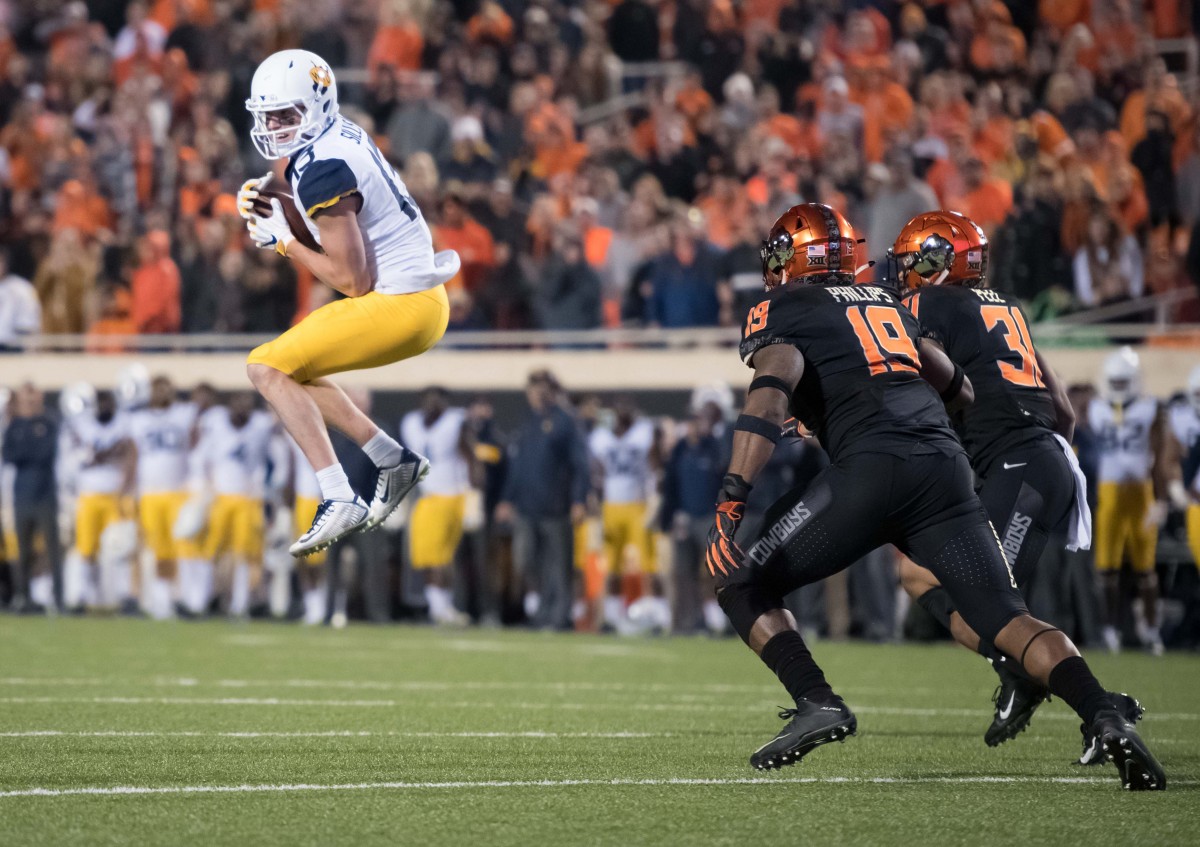STILLWATER, Okla. — The chief agony of any loss that comes down to one play is the reality that there were in fact multiple moments where the outcome of a different individual play likely would have changed the final score.
West Virginia’s 45-41 loss at Oklahoma State is no exception. It provided a case study in how a game hinges on multiple turning points, some of which only become obvious after the fact. The following moments stick out from Saturday’s game.
Second quarter — 5:00
The situation: West Virginia faces fourth-and-1 from the Oklahoma State 5-yard line. The Mountaineers decide to go for it rather than trying a chip-shot field goal to go up 24-14.
The outcome: Will Grier is stopped short of the chains on a quarterback sneak.
Why it mattered: If West Virginia had 3 more points on the board, it would have only needed a field goal to win the game on its final possession.
That said, it’s not the decision that should be regretted. Against an offense as explosive as Oklahoma State’s, an offense has to go for touchdowns over field goals any chance it can get. Had the Mountaineers converted, they would have had three or four more cracks at the end zone from inside the 5.
This came down a strong individual play by Cowboys defensive end Jarrell Owens, who went outside around left tackle Yodny Cajuste’s inside blocking assignment before Trevon Wesco — lined up as an H-back rather than a tight end — could reach him.
Third quarter — 7:23
The situation: Trailing 31-21, Oklahoma State faces fourth-and-1 from the West Virginia 47 and calls timeout to change its play.
The outcome: One play after the Cowboys were stuffed for no gain, running back Chuba Howard gains two yards for the first down.
Why it mattered: This was the key play on a 6-minute, 40-second drive that the Cowboys used to cut the deficit to 31-24 and wear down the West Virginia defense. With a stop, the Mountaineers would have taken over near midfield with a chance to put the game to bed with a touchdown drive.
Fourth quarter — 13:50
The situation: Oklahoma State faces first-and-10 from its own 43.
The outcome: The Cowboys take a deep shot downfield that is intercepted by Keith Washington along the sideline — or so it seems. Unfortunately for WVU, Washington’s foot is about six sizes too big and his toes come down out of bounds. Like a foul ball that’s just a long strike instead of a home run, this one is merely an incompletion.
Why it mattered: This was the back-breaking drive on which the Cowboys converted a third-and-20 and third-and-13 on their way to a touchdown that cut West Virginia’s lead to 34-31. Both of those plays were major defensive breakdowns, but only a matter of inches separated the Mountaineers’ defense from hero status.
Fourth quarter — 4:52
The situation: Down 41-31, Oklahoma State faces third-and-4 from the WVU 9.
The outcome: Quarterback Taylor Cornelius keeps a read-option and runs untouched into the end zone.
Why it mattered: A stop here would have forced Gundy to make a decision, and going for a field goal to cut the deficit to seven would have been the likely outcome.
To his credit, WVU defensive end Ezekiel Rose didn’t hide from the fact Cornelius was his responsibility on the play. He was in position to stuff Cornelius at the line of scrimmage, but bit on the fake to the running back.
“I missed a tackle on a touchdown, and I feel horrible,” Rose said. “I feel like the game is on me. That was my fault.”
In reality, there were still opportunities for Rose’s teammates to take him off the hook.
Fourth quarter — 2:42
The situation: Correctly sensing that his defense is gassed, Dana Holgorsen elects to go for it on fourth-and-6 from the WVU 49 in hopes of running out the clock before Oklahoma State can get the ball back.
The outcome: Wide receiver David Sills takes off in a dead sprint downfield. The only problem is no one else on the field is moving. It’s a false start. The senior Biletnikoff Award semifinalist did not appear to realize the snap count, taking off when Grier was trying to get the defense to jump.
Why it mattered: Now dealing with a fourth-and-11, West Virginia must punt. Just as Holgorsen feared, West Virginia’s defense could not stop the Cowboys, who took the lead with 42 seconds left.
Fourth quarter — 0:36
The situation: Will Grier scrambles for a 3-yard gain on the first play of West Virginia’s desperation possession.
The outcome: The Mountaineers don’t call one of their two remaining timeouts with the clock running.
Why it mattered: West Virginia was fortunate to get off a final play, finally using a timeout when Sills was tackled at the OSU 14 with two seconds left. Using a timeout when Grier was tackled would have saved 10 seconds — time to run one or two more plays that could have resulted in cracks at the end zone.
Afterwards, Holgorsen was adamant that the situation was handled properly, as it did not give the Cowboys a chance to substitute. But on the day before Les Miles was introduced as Kansas’ head coach, it felt like an homage to the Mad Hatter’s School of Clock Management.
“We gave ourselves a chance on the final drive,” Holgorsen said. “You can sit there and say I can’t manage the clock if I want too, but there was [42] seconds on the clock on we went down the field 75 yards and almost scored.”




